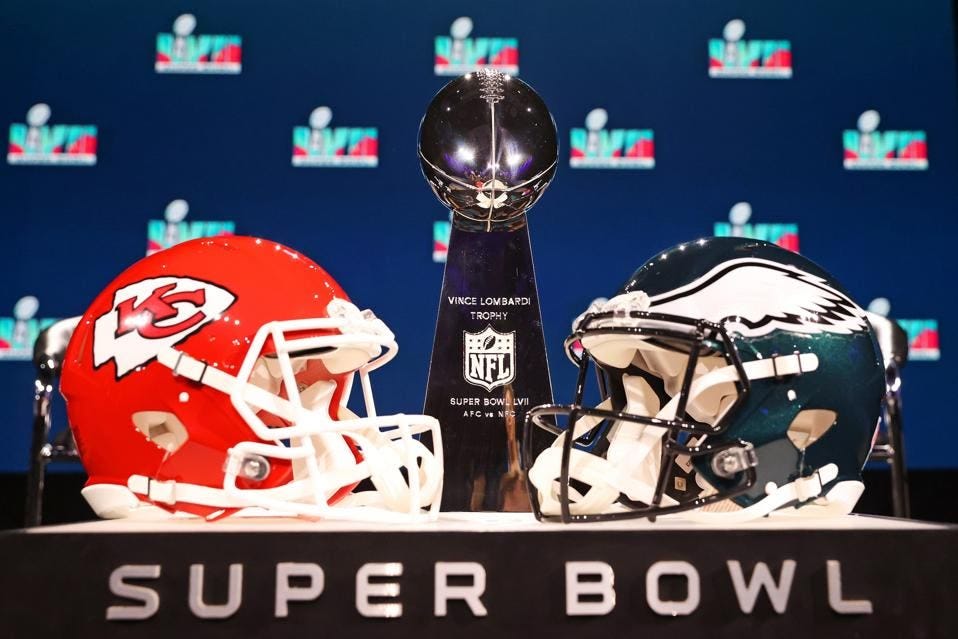An Chiefs-Eagles Super Bowl Was Less Predictable Than You May Have Thought
Although we just witnessed the lowest level of parity in the NFL this century, the Chiefs-Eagles matchup was not one of the more predictable in recent years.
I write this with a somewhat heavy heart as a lifelong Bills fan (sigh), but on Sunday, we learned that Super Bowl LIX will feature a rematch of the 2023 showdown between the Kansas City Chiefs and the Philadelphia Eagles. It’s a matchup that surprises few, given the incredible success of both teams during the regular season.
The Chiefs squeaked out a record string of one-score victories en route to a 15-2 record, with their second loss coming in a Week 18 matchup against the Broncos—a game in which Kansas City seemed allergic to playing anyone resembling a starter. Meanwhile, the Eagles ran through the season—literally—finishing 14-3 behind an all-time great campaign from RB Saquon Barkley.
However, while this battle between juggernauts may seem predictable, it is far from the most expected Super Bowl matchup in recent years, even amid this season’s historically low level of parity in the NFL.
A Season of ‘Haves’ and ‘Have-Nots’
This season featured an unusually high number of both very good and very bad teams. In fact, no season in the past 35 years—dating back to 1990—has seen more teams finish with winning percentages above .750 or below .250. In today’s 17-game format, that equates to records of 13-4 or better and 4-13 or worse (compared to 12-5 and 5-12 under the 16-game schedule used prior to 2021).
This disparity is also evident in the standard deviation of winning percentages across the league. Standard deviation measures how far individual values in a dataset deviate from the mean.1 The 2024 season had the highest standard deviation in winning percentage since 2000, highlighting the extreme variability in team records.
Interestingly, this followed the 2023 season, which had the lowest standard deviation in winning percentage. There’s no clear trend toward increasing or decreasing parity in the league, so a reversion to the mean in 2025 is entirely possible.
One might assume that this season’s lack of parity would lead to a highly predictable Super Bowl matchup. While the Eagles and Chiefs were among the league’s elite all season, this particular matchup did not rival the most predictable in recent years.
Super Bowl Probability
Using a logistic regression procedure incorporating various team-level stats—such as offensive and defensive metrics, conversion rates, and winning percentage—I estimated the probability of each team reaching the Super Bowl based on statistics alone. By multiplying the probabilities of an AFC and NFC team, we can determine the likelihood of any actual or hypothetical Super Bowl matchup.
This year, the most statistically probable matchup was Chiefs vs. Vikings, with a 3.4% likelihood—placing it near the middle of the most probable matchups over the past 25 years.
While these probabilities may appear low, it is because the probability is a relative measure, spread across the 16 teams in each conference. For example, a 20% probability may seem low for a heavily favored team, but one must remember that the remaining 80% needs to be spread across the remaining 15 teams. In this case, the average probability of the other teams would be a mere 5.3%. Matchup probabilities are determined using conditional probability—multiplying an AFC team's probability by an NFC team's probability—which naturally results in lower overall percentages.
Despite this, the model performed well in predicting Super Bowl teams, achieving an 81% accuracy rate, with a 96% sensitivity (correctly identifying actual conference champions) and a 77% specificity (correctly identifying non-conference champions).
So, even though the season lacked parity, their was still some uncertainty as to who would meet in the final game.
The Actual Super Bowl Matchups
Using the probabilities derived from the same model, we can determine the probability of each Super Bowl matchup that actually happened so far in the new millennium. While Chiefs-Eagles was a little more predictable, relatively speaking, compared to other matchups, it still falls short of being even in the top-five most predictable over the past 25 years, falling short of what would be expected from the season with the least parity over that timespan.
Oddly enough, the last Eagles-Chiefs Super Bowl was the most predictable, with a 5.4% relative probability based on stats alone.
Regardless of the predictability of the matchup, the Super Bowl never ceases to provide entertainment. This showdown between the Chiefs, who are seeking to become the first ever team to 3-peat, and the Eagles, whose QB Jalen Hurts is aiming to solidify his status among the elite QB’s in the league, is shaping up to be one for the ages.
Who’s do you think will take home the Lombardi Trophy on February 9th?




